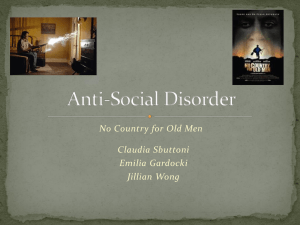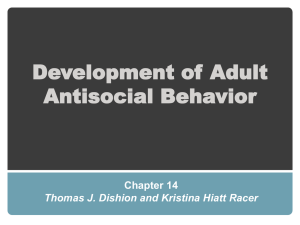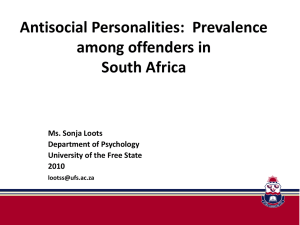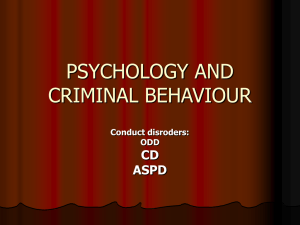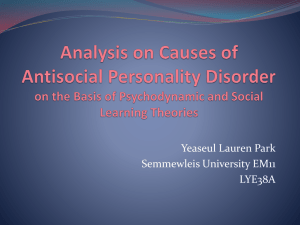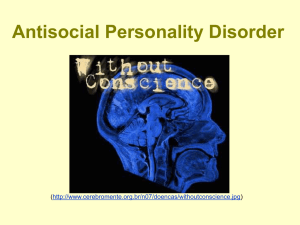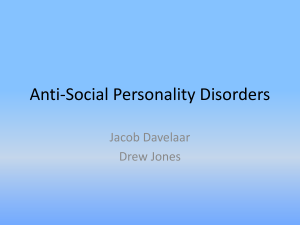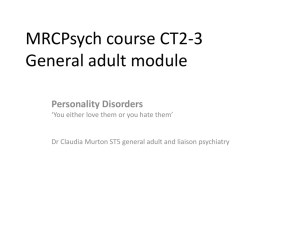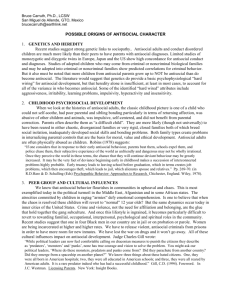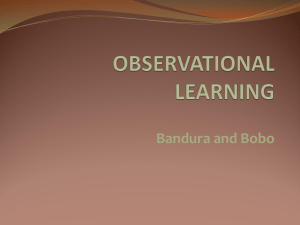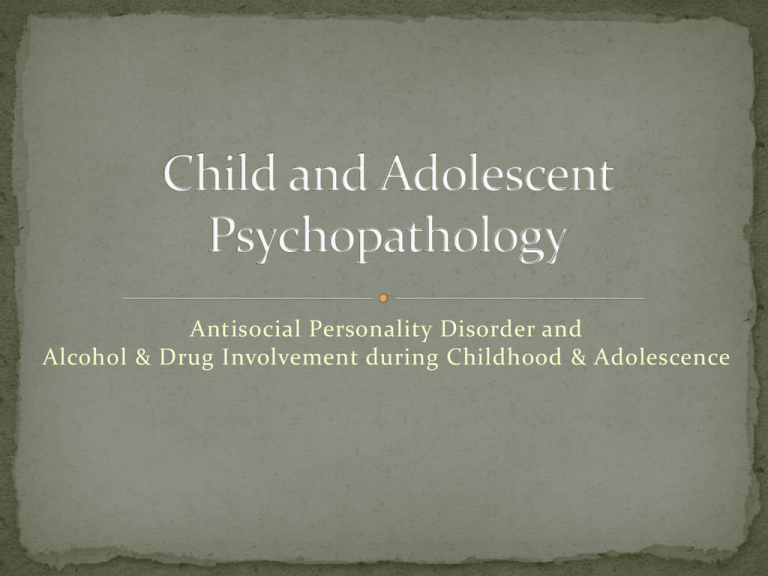
Antisocial Personality Disorder and
Alcohol & Drug Involvement during Childhood & Adolescence
Historical Perspective
Antisocial personality is innate (Hobbes)
Antisocial personality is learned (Locke & Rousseau)
Both perspectives are probably valid
Multiple pathways to antisocial
personality (equifinality)
Divergent outcomes for youth
(multifinality)
Definitions
Activities that violate societal norms, laws, or the rights of
others
Criminal acts – theft, fraud, assault, DUI, drug use
Noncriminal acts – deceitfulness, irresponsibility
Person must be 18 or older; otherwise, consider Conduct
Disorder (CD)
Antisocial behavior began before age 15
Sociopathy – old name for antisocial personality
Definitions (cont’d)
Psychopathy – subtype of
Antisocial Personality Disorder (APD)
Personality traits – callousness, shallow
affect, lack of interpersonal
connectedness, superficial charm
Chronic antisocial behavior
Assessed using the Psychopathy
Checklist-Revised (PCL-R; Hare)
80% of incarcerated persons meet
ASPD criteria, but ASPD represents a
heterogeneous group (which includes
psychopathy)
Prevalence
3.63% lifetime in an epidemiological sample
Three times greater risk among men
Risk factors
Childhood conduct problems – 54% of CD boys were
diagnosed with ASPD at age 18 or 19
Minor physical anomalies (MPAs) – low-seated ears,
adherent ear lobes, and furrowed tongues
(prenatal/perinatal trauma)
Low autonomic arousal
Persistent antisocial behavior has a genetic component
Developmental progression
Low parental involvement in middle childhood is
associated with persistent antisocial behavior in
adulthood
Peer rejection in childhood predicts ASPD because these
children adapt by forming friendships that support
deviance
Combination of well-organized
peer interactions and high levels
of deviancy training predict ASPD
(e.g., gangs)
Substance abuse facilitates
development of ASPD
Protective factors
Age (> 45)
Attachment to social institutions
(marriage, employment)
Decreased impulsivity and sensation
seeking
Parenthood and increased family
responsibilities
Academic success
Etiological formulations
Individual differences
Psychopathy is primarily biological or temperamental,
present at or near birth, persists throughout life course
Early starters versus late starters
o Early starters – coercive parenting, school failure, early
antisocial behavior
o Late starters – poor parental monitoring, oppositionality,
deviant peer involvement starting in adolescence
Environmental and relationship factors
Coercive parenting – intrusive demands, compliance refusals,
escalating distress, negative affect, withdrawal of demand
Peer influences
o Antisocial behavior interferes with positive peer relations
o Children act as models and a source of reinforcement for
this behavior
o Opportunity for this behavior within
networks of deviant peers
Social bonding – job stability and
marital attachment predict lower
rates of crime and deviance
Transactional process – bidirectional
effects between individuals and their
social environments
Comorbidity
ADHD – 30-50% meet criteria for ODD or CD
Substance abuse – ASPD men three times as likely to
abuse alcohol and five times as likely to abuse drugs;
ASPD women 10-13 times as likely to abuse alcohol and
12 times as likely to abuse drugs
Anxiety disorders and Depression
Cultural considerations – amplified by SES and
neighborhood risk factors
Physical spanking less problematic in African American
community
African American children receive more negative
feedback for school behavior and performance, more
likely held back and placed in special-education
African Americans have higher arrest and re-arrest rates
despite similar rates of antisocial behavior to European
Americans
Important moderators of antisocial behavior
Self-regulation – high effortful control
Less vulnerable to deviant peer influence
Need for cultural rituals and daily routine and chores
Biosocial factors – gene-environment interactions
Sociocultural factors – evaluate
systems-level policies
Improve behavior-management
practices of teachers
Improve academic instruction
Prevalence
12th grade – 80% have tried alcohol
Adolescents drink half as often as adults but consume
4.9 drinks per occasion compared to 2.6 drink per
occasion for adults
10% of 4th graders and 29% of 6th graders have had more
than a sip of alcohol
Greatest escalation occurs between ages 12 and 15
12th grade – 60% have tried nicotine
12th grade – 50% have tried marijuana
Problematic substance involvement predicts truancy,
suspensions, and expulsions
Abuse and dependence: Criteria and diagnostic issues
(p. 410)
Psychological dependence – subjective feeling of
needing the substance to function adequately
Physical dependence – physiological and psychological
adaptations
Tolerance – need to ingest larger
amounts to achieve same effect
Withdrawal – consumption ends
abruptly
Abuse and dependence are nonoverlapping diagnoses
Diagnostic criteria and issues (cont’d)
Withdrawal and physiological dependence less
prevalent but cognitive and affective withdrawal more
prevalent among children and
adolescents
Criteria might mot be sensitive enough
to identify adolescents with substance
use problems
Risk factors – nested in certain contexts
Temperament – high sensation seeking, behavioral
disinhibition, impulsivity, aggression, lack of behavioral
control, negative affectivity, antisocial patterns, trait
anxiety, anxiety sensitivity
Childhood behavior problems – hyperactivity,
aggression, CD, comorbid psychiatric disorders (selfmedicating; 60%)
Externalizing disorders – CD, ADHD, ODD
Internalizing disorders – depression, anxiety
Alcohol and drug expectancies
Peer and parental modeling and media exposure produces
more expected global positive effects, increased social
facilitation, enhancement of cognitive and motor
performance
Mediational model = family history of SUD
expectancies SUD
Age of onset – the earlier the age, the
worse the prognosis
Family influences
Family history = four-to-nine-fold risk
of SUDs in males, two-to-three-fold
risk in females
Parental deviance and
psychopathology
Peers
Greater access to substances
Adoption of beliefs and values consistent with drug-use lifestyle
Mediating variable between family history and conflict and SUD
Stress
Moderator of economic adversity on development of SUD
Bidirectional association (physical, academic, legal, peer,
familial, emotional)
Neurocognitive functioning – poor executive functioning,
which causes reduced ability to appreciate abuse consequences
Sleep difficulties – between ages 3 and 5
Protective factors – temperament, high intelligence,
social support, involvement with conventional peers,
religiosity, low-risk taking, competence skills, and
psychological wellness.
Developmental pathways to Substance Use Disorders
Deviance – prone pathway
Reduced ability to self-regulate emotional distress and inhibit
behaviors
Emotional distress caused by family history, ineffective parenting
Negative affectivity pathway – deficient regulation of
negative affect
Temperamental negative emotionality
Environmental stressors
Enhanced reinforcement pathway – less sensitive to
substances’ effects
Genetically influenced
Based on physiological response differences to SUD effects
Sex, race, and ethnic differences
Few sex differences
Native Americans most prone;
Asian Americans least prone
Developmentally dependent effects
Adolescent animals less sensitive to alcohol’s adverse
effects than adults
Adolescent animal exposure causes greater social
facilitation than adults
Adolescents have greater long-term behavioral and brain
impairment than adults
Adolescent animals have more tolerance, craving, and
motor impairment than adults
Adolescent frontal brain regions that control executive
planning and reasoning processes continue to mature into
adulthood

